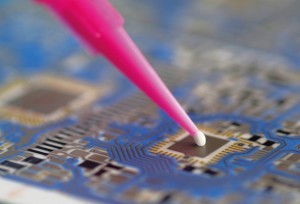Electronic devices are becoming smaller and more powerful, which increases the thermal load on the components. This not only shortens their service life, but also reduces their performance. Thermally conductive adhesives can help to optimize thermal management here.
Flexible in application
 The thermally conductive adhesive Elecolit 602 is applied to a printed circuit board (left)One of the main areas of application for thermally conductive adhesives is heat dissipation in power electronics. Here, the thermal load on sensitive electronic components is reduced by the thermal conductivity of the adhesive, thus ensuring that their performance is maintained. Thermally conductive adhesives are also used as encapsulating compounds for measuring sensors that are used to measure the temperature of housings or reactors. In comparison to thermally conductive pastes, adhesives with thermal conductivity have the advantage that they not only dissipate the high thermal energy, but also serve to fix and fasten at the same time.
The thermally conductive adhesive Elecolit 602 is applied to a printed circuit board (left)One of the main areas of application for thermally conductive adhesives is heat dissipation in power electronics. Here, the thermal load on sensitive electronic components is reduced by the thermal conductivity of the adhesive, thus ensuring that their performance is maintained. Thermally conductive adhesives are also used as encapsulating compounds for measuring sensors that are used to measure the temperature of housings or reactors. In comparison to thermally conductive pastes, adhesives with thermal conductivity have the advantage that they not only dissipate the high thermal energy, but also serve to fix and fasten at the same time.
In many applications, e.g. in computer technology or in the manufacture of modern, high-performance batteries in the field of electromobility, efficient heat dissipation and simultaneous electrical insulation are required. Thermally conductive adhesives, such as those from Panacol, can provide all of this.
It is essential to choose the right adhesive to ensure a reliable and durable bond. The most important prerequisites for the adhesive bond are precise dosing and good surface wetting with form-fit gap bridging, which also compensates for coarser unevenness in the joining surfaces. This allows a high adhesive strength to be achieved between a wide variety of materials (metals, ceramics, plastics). Modern bonding technology makes it possible to tailor adhesives to the respective application. This gives the designer great creative freedom and at the same time the dosing and curing of adhesives can be very easily integrated into most industrial production processes for individual or mass production.
Epoxy adhesives - a variable and reliable basis
 Application of two adhesives (Elecolit 6601 and Elecolit 6604) with different flow behavior - the different wetting behavior and dimensional stability are clearly visible (right)Solvent-free reactive adhesives or chemically curing systems are particularly suitable for many applications. These adhesives consist of low-molecular and therefore low-viscosity substances that react with each other under defined conditions. Epoxy resin-based adhesives are particularly suitable for this purpose, as they are highly reactive. Epoxy resin adhesives cure using various mechanisms (thermal, UV light, 2K). While single-component, thermal or UV-curing systems cure relatively quickly under precisely defined conditions, with 2-component systems a fast or slow curing process (short or long pot life) must be set by selecting a suitable resin/hardener combination.
Application of two adhesives (Elecolit 6601 and Elecolit 6604) with different flow behavior - the different wetting behavior and dimensional stability are clearly visible (right)Solvent-free reactive adhesives or chemically curing systems are particularly suitable for many applications. These adhesives consist of low-molecular and therefore low-viscosity substances that react with each other under defined conditions. Epoxy resin-based adhesives are particularly suitable for this purpose, as they are highly reactive. Epoxy resin adhesives cure using various mechanisms (thermal, UV light, 2K). While single-component, thermal or UV-curing systems cure relatively quickly under precisely defined conditions, with 2-component systems a fast or slow curing process (short or long pot life) must be set by selecting a suitable resin/hardener combination.
Epoxy adhesives are characterized by excellent adhesion to a wide range of substrates, good temperature resistance and high resistance to chemicals and solvents. Due to their high cross-linking density, adhesive layers made of epoxy resin base materials have high long-term static resistance under creep loads. If the adhesive layer is later subjected to deformation (dynamic load), specially formulated epoxy adhesives enable stress relief without damaging the bond. Skepticism about the long-term durability of bonded joints is therefore not justified if they are properly designed.
Thermal conductivity
In general, thermal conductivity is the amount of heat that passes through a body of defined cross-section in a certain unit of time. Non-metallic solids, such as cured adhesives or ceramic fillers, generally do not contain freely moving electrons. This means that heat is not transported via convection or conduction electrons, but only via lattice vibrations (phonons) and the resulting energy exchange.
Epoxy adhesives in themselves do not exhibit very high thermal conductivity (approx. 0.2 W/mK). Higher conductivity values can only be achieved by adding special fillers. The fillers are usually ceramic or metallic fillers, whereby the choice depends heavily on the area of application. Most thermally conductive adhesives achieve conductivities of 0.4 to around 1.3 W/mK; depending on the application, conductivities of up to around 3 W/mK can be achieved with Panacol's Elecolit adhesives. Ideally, thermally conductive fillers should have high thermal conductivity, low thermal expansion, low abrasiveness and good chemical resistance.
Fillers - only the right filling provides the right cooling
 Elecolit thermally conductive adhesives (shown in blue in the picture) are suitable for bonding heat sinks to dissipate heat from power electronics In principle, the higher the thermal conductivity of the pure filler, the higher the thermal conductivity at a constant filler volume fraction. However, every filler has a number of advantages and disadvantages, meaning that choosing the right filler is anything but trivial.
Elecolit thermally conductive adhesives (shown in blue in the picture) are suitable for bonding heat sinks to dissipate heat from power electronics In principle, the higher the thermal conductivity of the pure filler, the higher the thermal conductivity at a constant filler volume fraction. However, every filler has a number of advantages and disadvantages, meaning that choosing the right filler is anything but trivial.
The best thermal conductivity values can be achieved with fillers such as silver or other metals. However, metals also have an electrically conductive effect, which is not desirable in many applications. To achieve thermal conductivity with simultaneous electrical insulation, adhesives with ceramic or mineral fillers are therefore preferred. However, ceramic fillers have the disadvantage of being highly abrasive due to their high hardness. A problem that can be greatly mitigated by the particle shape. One material with excellent heat-conducting properties is boron nitrides, for example. Although these lead to high thermal conductivity, their shape usually results in unfavorable flow properties. In addition, boron nitrides are very expensive.
An alternative is to fill the adhesive with aluminum oxide (Al2O3). Aluminum oxide is a white, opaque high-performance ceramic. This ceramic is extremely temperature-resistant and also has high mechanical strength.
However, the greatly differing thermal conductivity of the various fillers does not have a correspondingly proportional effect on the thermal conductivity of the adhesive. One explanation for this behavior lies in the different geometries of the filler particles. Basically, the higher the number of contacts between the individual particles, the higher the conductivity. Depending on the shape and size of the respective filler particles, there may be more or less epoxy polymer between the particles with the same volume fraction, thus forming a thicker or thinner insulating separating layer that hinders heat transport. Accordingly, the thermal conductivity of the adhesive increases with increasing filler content. Laboratory tests have also shown a strong dependence on the particle geometry. For example, a slightly higher thermal conductivity tends to be achieved with irregularly shaped aluminum oxide particles than with round particles with the same volume fraction. On the other hand, a significantly higher degree of filling and ultimately a higher conductivity is achieved with round aluminum oxide, while at the same time a good processing viscosity can still be guaranteed. Depending on the application, a mixture of different filler types, filler sizes and geometries can also be advantageous for conductivity and flow behavior.
Flow behavior of thermally conductive adhesives
In addition to the filler level and particle size distribution, the material type and particle shape have a major influence on the subsequent properties. The filler material influences the flow behavior of the adhesive. The setting of the desired viscosity is decisive for the subsequent application: while too low a viscosity does not guarantee edge stability or causes the adhesive to run unintentionally, too high a viscosity often leads to incorrect application of the material, as a rough surface, for example, is not wetted with a positive fit. Too high a viscosity can also be problematic during the dispensing process.
Viscosity values are not constant values, but are influenced by many conditions. This applies in particular to adhesives, as these tend to form an internal structure due to their polymer base. An effect that is further intensified by the addition of fillers. Under shear stress, a certain orientation of the particles in the direction of flow occurs. These then slide past each other more and more easily as the load increases. This results in a shear-thinning or structurally viscous behavior in filled adhesives, i.e. the viscosity values drop as the applied shear rate increases.
When using thermally conductive adhesives, care must be taken to ensure that the fillers are distributed as densely and homogeneously as possible within the adhesive. This is the only way to avoid cavities in the cured adhesive layer, which lead to a reduction in thermal conductivity. It is therefore not only important for the manufacturer to ensure careful production, but also that the user applies the adhesive correctly, for example to prevent the unintentional introduction of air during the dispensing process. In addition, attention must be paid to possible sedimentation during storage.
Conclusion
In addition to the filling level, properties such as the shape and size of the particles play a key role in the conductivity of adhesives. By carefully selecting the right filler, the flow properties, thermal conductivity and requirements for the cured adhesive can be specifically optimized. When selecting the adhesive, it is generally very important to match both the fillers and the adhesive formulation to previously defined, application-specific criteria. For example, it is also possible to achieve high dielectric strengths of over 25 kV/mm. This is a property that represents an important challenge in industrial electronics production when insulating live parts.
Adhesive developers therefore have a wide range of options at their disposal for adapting the properties of thermally conductive epoxy adhesives precisely to the relevant application. Modern thermally conductive adhesives are therefore able to take on very demanding and diverse functions, which will further expand their areas of application in the future.


